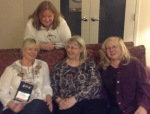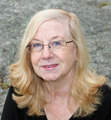Lea Wait's Blog, page 158
August 15, 2019
Take That Leap!
My daughter approached me with a devious smile on her face.
“What’s up,” I asked.
”Do you know what I did yesterday?”
Having no idea, I shook my head.
”I went skydiving.”
I nearly fell off my seat. She only told me afterwards because she knew I’d try to talk her out of such a crazy stunt. Skydiving is something I’d do as last resort, like if my plane had lost a wing and was going down in flames. And yet as shocked as I was, I was also secretly proud of her for challenging herself.
It was a reminder that sometimes in life we need to take risks. Now, I’m not necessarily talking about jumping out of planes or bungeeing off cliffs. Sometimes the risks we take in life can be elsewhere, concentrated, subtle. As a writer, it’s almost required to sometimes go out on a limb.
i’ve taken a few risks in my writing career, from switching genres to plotting farfetched narratives that went beyond the pale. Sometimes it worked. Other times it didn’t. Each time I ventured out there, I’ve learned something about myself. Failure has emboldened me. In fact, I’ve failed so many times in my writing career that failure feels like a close friend. Not actually a friend but the enemy of my enemy. I still fear failure as much as always, but I’ve also come to accept it as necessary part of the creative—the growth—process. It’s the difference between the younger me and the current version.
Adrian McKinty, the 51-year-old Irish crime novelist, had given up writing in 2017 because of tepid sales. Despite penning a dozen award-winning, literary crime novels, and gaining fans and notoriety, his books failed to reach a wider audience. He lost his house. Money was right. So he took up bartending. Encouraged by some writing friends and an enthusiastic L.A. agent, he stepped out on a limb and wrote THE CHAIN, a gripping page-turner quite different from his brooding, literary novels. It’s an ingenious plot, risky and inventive, and quite a harrowing read. I devoured it in a day. The result: THE CHAIN became a New York Times bestseller and Paramount bought the film rights.
[image error]
Embrace risk-taking. I don’t like failure as much as the next person, but failure can help you improve in life—in all aspects of life—and force you tosee where you went wrong.
When you get knocked down, pick yourself up off the floor. Wipe the dirt off your ass and prepare yourself to kick ass. Then go out on a limb. Take that one chance you’ve been waiting for. You never know, that next book you write could be the big blockbuster. That risky decision my get you promoted. That new recipe might land you your own food show.
Just don’t ask me to jump out of a plane.
[image error]
August 14, 2019
A Summer on the Road
Kate Flora: It seems like every summer, despite the deadlines that loom, instead of [image error]sitting peacefully at my desk, occasionally glancing out at blue sky and blue sea, I am in my car, driving to libraries and book events all over the state. It’s an adventure that I welcome. Writers love libraries, and Maine librarians are a generous and enterprising bunch.
Often, when I’m driving, I wish that I had a sidekick to chat with, or to take pictures of the many delightful and crazy things I see along the way. Recently, driving back in the rain from one of our Making a Mystery events at the Rangeley Library, there was an incredible sunset in my rearview mirror and a stunning rainbow ahead of me. I wanted to take their pictures, but there was massive road construction, the roadsides were a muddy mess, and I figured that if I indulged the impulse, I would be mired in mud. Not a fun way to end a wonderful day.
[image error]On a recent trip to Blue Hill, I was lucky enough to meet good friends beforehand for a delicious dinner at Arborvine before presenting with the fabulous panel of Bruce Coffin and Katherine Hall Page, moderated by Chris Knopf with books by Blue Hill Books. At the library in Belgrade, where I was joined by Maureen Milliken and Sandy Neily, we were honored by the presence of the brand new town manager, and my brother and his wife showed up. Traveling around Maine is a chance to make new friends as well as new readers.
There are actually two benefits to these library events: the enthusiastic readers we meet there, often readers who are unfamiliar with our work or readers who are eager to know when a new book will debut; and the pleasure of seeing how other writers respond to the questions and comments based on the type of books they write and their individual writing practice.
Want to know about how we do research or what are writing schedules are? Just show up at an event and ask.
In the case of Making a Mystery, the panel of writers will be responding to the


interesting prompts the audience provides. If some of you aren’t familiar with the concept of the Making a Mystery program, here’s a brief sketch. At the beginning of the evening, attendees are given index cards, and invited to write character names, settings, motives, weapons, and occupations on individual cards. The cards are then placed in individual bags. A scribe is appointed to keep track of the evolving story. Then writers who represent different areas of the mystery genre, such as cozy/traditional, noir, police procedural, thriller, suspense, etc. begin to compose a story, explaining along the way how various considerations of their particular subgenre come into play in writing the story.
This summer, I’ve had the pleasure of presenting this program with other writers in Belgrade, Rangeley, and Maynard, Massachusetts. This coming Wednesday (aka today!) Bruce Coffin, Dick Cass, and I will be doing one in Freeport. Other groups of writers can be found composing mysteries on the fly in other parts of the state.
Of course, there are other destinations besides libraries. A recent picking trip to my blueberry field in Union, which has gone organic for the first time this year. A visit to the no-to-be-missed Coastal Maine Botanical Garden. A trip from Boothbay Harbor to see the puffins. A visit with the mystery mavens at Mainely Mysteries in Kennebunk. Lunch with Governor Mills and a view of her gardens. And of course, there is still more of summer to be enjoyed.





August 12, 2019
Summer Favorites
Susan Vaughan here. Summer is winding down (sorry for mentioning that), and here in Maine that’s mid August. I’ve finished the latest manuscript and am waiting for feedback from beta readers. So I want to share what I appreciate about summer beyond the warm weather and especially this summer.
LIVING BY WATER: I’m lucky living on a tidal river where I can watch the tides change [image error]and the gulls and eagles from my deck. We also have a cottage on a lake not far away, where we can boat and swim. There, I especially enjoy the loons. They serenade us at night calling to each other as their sleep lets them drift apart. A couple summers ago, the loon pair in our cove had a chick that we named Rocky. Rocky’s on the right, but hard to see. They let us get close enough in the canoe for a photo. It’s a little blurry but I love the reminder. One day, the parents set up an alarm when an eagle tried to snatch up Rocky, but the chick had dived out of danger, and the eagle left. An adult loon is too heavy for even an eagle. Loon chicks can dive about two weeks after hatching.
[image error]
THE GARDEN: Last year’s garden didn’t do that well, partly because of the lack of rain. This year we got a late start because we were traveling two weeks in May, but the summer heat has spurred growth, and we’re beginning to harvest lettuce, radishes, and cucumbers. The pole beans are slowly growing, and I have hope. But the deer ate the tops of the sunflowers (I love sunflowers!), so not much hope there.
DECK: Summer is my time to enjoy the deck, both at home and at the lake. Sitting with my [image error]feet up, either reading or sketching out a new plot, on the deck is the best, especially at the lake. My dog Sasha, an unidentifiable mix, avoids the water as if it were acid, but the neighbors’ black lab will endlessly jump off their dock after a ball or stick. Fearful she’ll tire herself out too much to swim back to shore, they eventually drag her out of the water. Or maybe it’s because of their tired throwing arms.
We began only paddling, with a canoe and two kayaks, but three years ago, we acquired an 18-foot bowrider second hand, purchased in part by my book royalty money, thus the name. We still use the other craft, but for trips around the lake the powerboat is a must.
[image error]
VISIT TO NEW HAMPSHIRE: This July, we spent several days in the Granite State, first to visit family on Lake Winnipesaukee (yes, more water). We had fun with our small great-nieces and their parents and enjoyed more boat rides. The little girls made Play-Doh pancakes and fed them to my husband. To their delight, he pretended to eat them.
[image error]
Then we went to Mount Washington, in the Presidential Range of the White Mountains. For those not familiar with this peak, it’s the highest in the Northeast at 6288 feet.
[image error]
Mount Washington
This picture I took at the top shows the Appalachian Trail leading to its northern end on Mount Katahdin, 332.4 miles away in Maine. By contrast, Katahdin is a mere 5268 feet high.
[image error]
Mount Washington is known for extreme weather conditions and especially high winds. The treeless summit is accessible by road, by hiking trails, and by a railway with both steam and diesel engines.
[image error]
Steam Train atop Mt. Washington
We rode the cog railway, begun in 1869. Our single coach was powered by a coal-powered steam engine. I recommend the train for the views up and down (choose to sit on the side with 3 seats) and for the brakeman’s entertaining and informative commentary. Atop the mountain are the Mount Washington Weather Observatory and other buildings open to the public only in summer.
One is the Tip Top House, a hotel built in the mid 1800’s for hikers and early cog railway riders, and restored in the 1960’s as a museum. The bunkroom held about 10 wooden bunks, top and bottom, with curtains like on a Pullman train car. No luxury accommodations there, and the only heat was coal stoves in the other two rooms. I shuddered to think of sleeping on those hard bunks and was happy to ride down the mountain to our hotel with its comfy bed.
[image error]
Tip Top House
What is your summer favorite? (No fair saying warmer temperatures.)
That’s No Earthquake, It’s Shakespeare Rolling In His Grave
We’re ready to use the fire pit, thanks to cleanup.
We’re nicely settled in. Beth has painted all but one room, while I’ve helped hang pictures, quilt racks, etc. My major efforts have gone toward clearing the twenty or so feet of jungle at the back of the property. Our neighbor showed us a piece of what I’m now calling ‘Demon Vine,’ but research reveals it to be Asiatic Bittersweet (https://www.maine.gov/dacf/mnap/features/invasive_plants/celastrus.htm). Some of the vines I’ve cut have been two inches in diameter. Diligent sawing and clipping has revealed several large oak trees, one spruce, a pine and a huge maple that toppled across the property line a few years back. When the job is finished, there should be room for at least two plum trees and a small raspberry patch.
[image error]
Some of the flowers we’ve added. There’s a wonderful greenhouse 4 miles up the road.
While I work, my mind tends to wander in odd directions and the result is a slightly offbeat offering this time around. It got its start when my friend Tim Hallinan challenged his facebook friends to come up with the worst song ever. Trust me, the list was extensive and funny as hell. It got me thinking about the possibilities inherent in theatrical mashups, blending two plays together and how the result might be described. Keep in mind this list is far from inclusive and would probably be different in a week. That’s the fun nature of creativity. I invite you to submit your own creations in the comments section.
[image error]
Some of the freshly cut vine still hanging.
A Midsummer Night’s Cat on a Tin Roof: Cleo, A Maine Coon Cat, tires of being a mouser on a rural farm and hitches a ride with an unsuspecting trucker driving a load of milk to New York City. This is the story of his rise to stardom as lead in an off-Broadway meowsical.
A Streetcar Named The Glass Menagerie: If you thought Oh, Calcutta was risque, you’re in for a big awakening when you see this musical comedy about a bunch of San Francisco exhibitionists who ride all night in a brightly lit see-through trolley car
Caucasian Chalk School for Scandal: What happens when a bunch of merry pranksters invade a school for mimes in oh so proper Omaha, Nebraska? Buy tickets and find out.
Hedda Gabler and the Man: Granddaughter of the original Hedda, This heroine is much cooler, hip even. She’s of mixed race and just graduated from John Jay College with a degree in criminology. Eager to take on the bad guys, this drama is the story of her first year as an undercover narc in Wilkes-Barre, PA.
Inherit the Little Shop of Horrors: What might have happened if William Jennings Bryan had realized there was more to life than ‘crosses of gold’ and monkey trials. Imagine him discovering he’s just inherited the funkiest flower shop in Peoria, Illinois. Plan a night at the theater and watch the fun begin.
[image error]
Our place from the back
Long Day’s Journey Into A Comedy of Errors: What happens when an about to retire bus driver reluctantly agrees to take the worst class of seniors ever graduating from Sister Jon Damian High School on their class trip. Little does he know that Scad Pritchert, the worst of the lot, has reprogrammed the GPS on the bus, setting them on a course for Death Valley instead of San Diego.
Master Harold and the Boys Look Back in Anger: Headmaster of an isolated seminary in the Cascade Mountains, Harold Winert, lets his guard down when one of his seminarians breaks open a barrel of sacred brandy, intended for rescue dogs to carry in little casks during the upcoming winter. It’s been a cold, gloomy and cruel fall, leaving him embittered and second guessing his entire life. Once the brandy begins flowing, everyone starts lamenting their lot and by the time the brandy is gone, the talk and emotional climate are beyond scary.
Much Ado About The Cherry Orchard: Remember Heckel and Jeckle? Few knew they were originally from Russia and far from ordinary avians. This is a dark comedy about their relatives who not only are able to think and plan, they can see in the dark. When they plot to strip the famed St. Olaf cherry orchard over a weekend, the results are unexpected and extremely funny. Who knew fruit on the tree could induce hysterics?
No Exit, Oklahoma: Existentialism in Muskogee? Who knew. This tragedy is the story of what happens when Jean Paul Sartorial, fresh from deputy training in Elk City, OK, tries to bring law and order to Broken Arrow. The results are cringeworthy, but a must-see night of theater.
She Stoops to Conquer Angels in America: What happens when Betsy Devos tries to eliminate sex education from the San Francisco area school districts? Imagine Hair meets The Tight White Collar on the way to Woodstock and you’d be close. Dress casual if planning to attend because this has become a fast favorite of The Rocky Horror Picture Show fans.
Six Characters in Search of The Merry Wives of Windsor: After waiting decades to be let loose, August Pindar’s creations are ready to Paaarty. So, it seems are Shakespeare’s ladies. Expect the unexpected when you find your seat.
Six Degrees of A Chorus Line: What happens when the stars of a Broadway musical are offered free DNA testing by an anonymous benefactor. The results are relatively hilarious and completely unexpected, Performances change nightly.
The Taming of the Playboy of the Western World: What happens when People Magazine’s most eligible bachelor falls under the spell of the world’s most powerful dominatrix? Well, let’s just say that whips, chains, lots of chocolate syrup and whipped cream are involved. If planning on attending, bring your imagination, but leave any prudery at home.
Now it’s your turn to fire up the creative juices.
August 9, 2019
Weekend Update: August 10-11, 2019
[image error]Next week at Maine Crime Writers, there will be posts by John Clark (Monday), Susan Vaughan (Tuesday), Joe Souza (Thursday) and Kaitlyn Dunnett/Kathy Lynn Emerson (Friday).
In the news department, here’s what’s happening with some of us who blog regularly at Maine Crime Writers:
Kate Flora: On Sunday, August 11th, Kate Flora and Bruce Coffin, joined by Joseph K. Loughlin, will be at the Vinegar Hill Music Theater in Arundel. Starting at 6:30, we will be discussing writing about the police in fiction and nonfiction. Going to be a fascinating evening.
Kate Flora: On Wednesday, August 14th, Bruce Coffin, Dick Cass and Kate Flora will be doing a “Making a Mystery” program at the Freeport Library.
We are very sad to share the news that our dear friend, the amazing Lea Wait, died at home on Friday morning in the company of her daughters. We will post information about services when they become available.
An invitation to readers of this blog: Do you have news relating to Maine, Crime, or Writing? We’d love to hear from you. Just comment below to share.
And a reminder: If your library, school, or organization is looking for a speaker, we are often available to talk about the writing process, research, where we get our ideas, and other mysteries of the business. Contact Kate Flora
August 8, 2019
Best of Summer – A Story in Photographs
Is there anything more wonderful than summer in Maine? I think not.
In lieu of a lot of words today, I offer a collage of photos documenting the wonders of our gorgeous state taken in July and August, from the vantage point of beautiful Hancock County.
[image error]
Honor system blueberry stand – six bucks a fresh-picked quart
[image error]
The most perfect place to swim
[image error]
Library with al fresco writing annex
[image error]
A Greater Yellowlegs in the shallows
[image error]
A Blue Heron fishing at sunset
[image error]
Foggy mornings usually give way to sunny afternoons
[image error]
Local markets with fabulous produce are everywhere
[image error]
A safe harbor
[image error]
‘Tis the season for creative literary fundraisers . . .
[image error]
. . . and sightings of Maine crime writers in the wild. Last evening we were delighted to catch Paul Doiron speaking about his newest Mike Bowditch novel, ALMOST MIDNIGHT, at Brooklin’s Friend Memorial Library.
[image error]
August blooms
[image error]
Wonderful, scenic hikes
[image error]
The views go on forever
[image error]
One last sunset
Photos by Brenda Buchanan and Diane Kenty.
Lea Wait – An Update
We know that our MCW readers are thinking of Lea, as we are, and wanted to share this brief update about her condition. At the moment, she is having in-home hospice, with pain meds every four hours. All four of her daughters are with her. She is unable to respond to e-mails or take phone calls, but wants us to know that she appreciates the e-mails and messages of love and support that readers and friends are sending.
[image error] [image error]
[image error]
My 4 daughters right after Liz’ wedding. From l-r, Caroline, Ali, Liz, and Becky.
[image error]



[image error]
Past and present MCW bloggers: Chris Holm, Brenda Buchanan, Jim Hayman, Lea Wait, and Bruce Coffin
August 5, 2019
Details, details
Every writer faces the question of how much detail to provide about characters and settings. Am I describing enough? Too little? Too much? How much do my readers need, or want, to know in order to understand the character I’m describing or the room in which the murder takes place? Reviewers criticized me, albeit gently, for not giving enough physical description of the main character in my first mystery. I tried to respond by adding more details in subsequent novels, though I confess I didn’t think that mentioning hair color or nose shape added much of value since what a character thinks or says seems to me more important. I’m still wrestling with how descriptive I should be.
This question came to mind again recently when I read Rick Atkinson’s The British are Coming, the first volume of his projected three-volume history of the American Revolutionary War. I’m an early American history fanatic, though military history as such isn’t of great interest. Still, I was inspired to read Atkinson’s history because Joseph Ellis, an early American historian I respect greatly, gave it a superlative review in the New York Times. It’s an impressive piece of work, drawing on practically every secondary source on the Revolution and a great deal of primary material, including letters and diaries of combatants and especially newly public writings of George III about his rebellious subjects in America. And Atkinson is a facile writer of clear, easily read prose.
[image error]
The Battle of Trenton
But he drove me crazy because of his, for my taste, vast overuse of details and unnecessary description. For both the rebels and the British he catalogs every pound of saltpeter and gunpowder, counts every rifle and canon, and names every ship. As I said, military history has little appeal to me, so I was willing to skim through such lists on the assumption that his primary audience wants them. What really bothered me is his description of people. When a new soldier enters the scene, we get a detailed picture. Colonel John Glover is “a short, burly, forty-three year old with a high forehead and a jutting jaw.” What’s important here is Glover’s age: at 43 he was toward the upper age of militiamen. But what’s really important about Glover isn’t captured in the physical description. He led a militia of Marblehead fishermen who saved Washington’s army when they evacuated troops by boats from Brooklyn to Manhattan in rain and dense fog. And Glover’s men were there again to ferry troops and horses across the Delaware for Washington’s surprise attack on Trenton
>Why did Glover, at his age, give up his comfortable life in Marblehead, raise a militia of fishermen, and serve the American cause so valiantly? And why did those men join him? Answers to those questions don’t come from knowing he was short and burly and had a high forehead and jutting jaw.
Here’s another example. Going into the battle for Charlestown,[image error]
“the column was led by a sinewy, azure-eyed colonel wearing a blue coat with a single row of buttons and a tricorne hat>So what? What motivated this colonel to risk life and limb to roust the British? Why should I care about the color of his eyes or coat? One answer, of course, is that Atkinson makes the scene vivid, painting with words to make the reader feel she’s present. But for me, the description is not just unneeded but intrusive.
[image error]
General Henry Knox
Henry Knox is a great figure in American, and ultimately Maine, history, but I don’t think it helps us to understand how he became so to know that the bookstore he kept in Boston before he joined the cause was “an emporium offering stationary, wallpaper, quills, flutes, Keyser’s pills, telescopes, ‘cordial cephalic snuff,’ reading glasses, and Hill’s ‘never-fading cure for the bite of a mad dog.’” Do those words create images that make his bookstore vivid for us? Not for me
The British are Coming is a good read, especially for folks who like to know about wars, but it’s a fair criticism to say it’s overwritten, dense with irrelevant details, and badly in need of a sharp editorial pencil. Atkinson is a highly successful author who makes a mint from his writing, and his latest will add to that. Hats (tricornes?) off to him for that. I should be so successful. But his style raises a serious question for me as both writer and reader. Just as every writer has to decide how much to describe, every reader has to decide when enough’s enough already. Obviously the answer is the usual: it depends—on purpose, taste, genre, and so forth. Cop mysteries around violent murders need bloody details. Cozies can prioritize inner to outer description. And so forth. I’ve had my say on this and would be interested to know what other writers and readers think, understanding that choices are at the heart of the writing enterprise.
August 4, 2019
Less Being More
I’m still fan-boying over my trip to Erin French’s Lost Kitchen [image error]last month, a bit of serendipity that comes from having good friends and a flexible notion of how far to drive for a good meal. Beyond the beautiful setting in an old mill building, the wonderfully languid pace of the meal, the gorgeously presented food, and the joy in which the whole place seems dipped, I was reminded how much I’ve learned that less is more.
As a young writer, I focused on quantity—number of words, number of hours—channeling Malcolm Gladwell’s 10000 hour rule probably before he thought of it. I wouldn’t deny myself those four AM mornings, that focus and effort—as Oliver Sacks has said, “We must not condescend to our younger selves.”—but I started to realize that there were limits to the amount of creative energy I could expend.[image error]
I heard J. A. Jance say once at a conference that everyone has about enough creative energy in a day to play a good game of chess, at best, a few hours. So I slowly came not to believe in the exhaust-yourself ethic that’s part of the myth of the artist.
These days I’m happy with a daily solid working effort—I still count words, but not so religiously as I once did—that doesn’t exhaust me or steal from tomorrow’s work. And I hope to achieve in that concentrated few hours of effort something like the gift of attention I felt bestowed on me at the Lost Kitchen.
The owner plated as many meals as the kitchen folks, delivered as many meals as the wait staff, and managed to engage nearly everyone, looking us all in the eye as she spoke to us as if we were the only guests she had that night. It reminded me what I aspire to in my work: full effort, an unapologetic focus on the value of what I’m trying to do, but a light touch and an effortless generosity, the kind of attitude that brings you a fresh cool towel at your dinner table on the hottest night of the year.
August 2, 2019
Weekend Update: August 3-4, 2019
[image error]Next week at Maine Crime Writers, there will be posts by Dick Cass (Monday), William Andrews (Tuesday), Lea Wait (Thursday) and Brenda Buchanan (Friday).
In the news department, here’s what’s happening with some of us who blog regularly at Maine Crime Writers:
An invitation to readers of this blog: Do you have news relating to Maine, Crime, or Writing? We’d love to hear from you. Just comment below to share.
And a reminder: If your library, school, or organization is looking for a speaker, we are often available to talk about the writing process, research, where we get our ideas, and other mysteries of the business. Contact Kate Flora
Lea Wait's Blog
- Lea Wait's profile
- 506 followers



